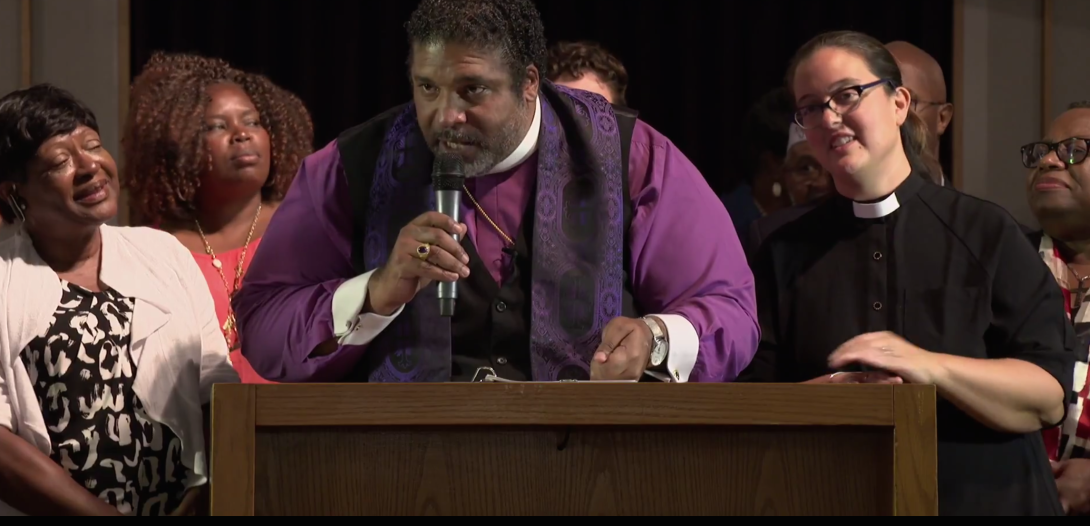INSTITUTE INDEX: The urgent need for the New Poor People's Campaign

Bishop William Barber and, to his left, Rev. Dr. Liz Theoharis led a mass meeting at Antioch Missionary Baptist Church in Charlotte, North Carolina, in August to discuss preliminary plans for a New Poor People's Campaign. They'll take the campaign nationwide with a press conference in Washington on Monday, Dec. 4 — 50 years to the day after the Rev. Dr. Martin Luther King Jr. kicked off the original Poor People's Movement in Atlanta. (Image is a still from this Repairers of the Breach video.)
Date that Bishop William Barber of North Carolina's Moral Movement, Dr. Liz Theoharis of the Kairos Center and its Poverty Initiative, and other clergy and organizers will visit Washington, D.C., to announce the launch of the New Poor People's Campaign, an anti-poverty effort involving nonviolent civil disobedience in state capitals nationwide: 12/4/2017
Number of years before to the day that Rev. Dr. Martin Luther King Jr. announced the original Poor People's Campaign at an Atlanta press conference, warning of "the presence of a kind of social insanity which could lead to national ruin": 50
Number of people the first campaign mobilized to travel to Washington, D.C., in the spring of 1968 to petition the government for an Economic Bill of Rights, which was never passed: 3,000
Among the campaign's wins, which included more money for the food stamp program and school lunches in Alabama and Mississippi, number of the nation's poorest counties to which the U.S. Department of Agriculture released surplus commodities: 1,000
In the mid-1960s, percent of what were then classified as "nonwhite" Americans who lived below the poverty line: 41.4
Percent of black Americans who live in poverty today: 22
Percent of Hispanic Americans: 20
Of white Americans: 9
When King launched his campaign in 1967, percent of total U.S. income earned by the wealthiest 1 percent of Americans: about 10
In 2015: 22
Between 1963 and 2013, amount by which the gap grew between the average wealth of white families on the one hand and African-American and Hispanic families on the other, as measured in 2013 dollars: $383,000
Of the 100 U.S. counties with the highest rates of inequality, number in the South: 77
Percent of residents of Lowndes County, Alabama, who recently tested positive for hookworms, health-damaging intestinal parasites associated with extreme poverty that were thought to have been eradicated from the U.S. decades ago: 34
Percentage points by which the poverty rate in majority-black Lowndes County exceeds that of the U.S.: 22.5
Percent of Lowndes County's white residents who live in poverty: 3.4
Percent of its African-American residents who do: 37
Factor by which extreme poverty in the U.S. — defined as households living on less than $2 a day before government assistance — increased between 1996 and 2011: almost 2
Under the Senate tax reform plan, which critics say "supercharges" inequality, year by which people earning less than $30,000 a year would be worse off: 2019
Amount by which it would cut the tax bills of the top 0.1 percent, on average: $208,060
By ending the Affordable Care Act's individual mandate, additional number of Americans the plan would leave without health insurance coverage by 2025: 13 million
Number of states the New Poor People's Campaign visited in recent months to build support for the initiative: more than 15
Number of state capitols where the campaign plans to engage in nonviolent direct action: 25
Number of people who've already been arrested while engaging in nonviolent civil disobedience in North Carolina as part of the Moral Movement: 924
Number the New Poor People's Campaign hopes to involve in similar actions: tens of thousands
(Click on figure to go to source.)
Tags
Sue Sturgis
Sue is the former editorial director of Facing South and the Institute for Southern Studies.
